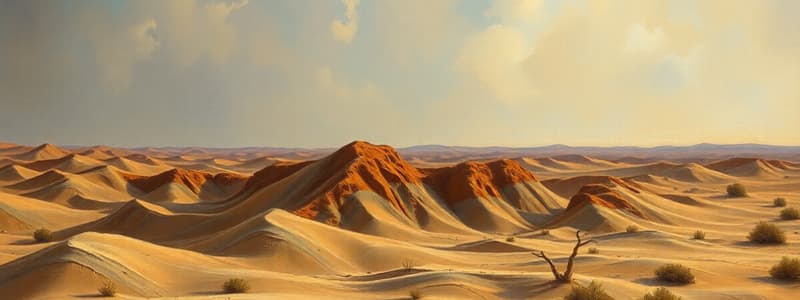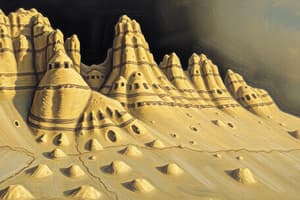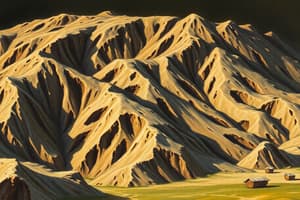Podcast
Questions and Answers
What is a primary factor that influences the transport of particles by wind?
What is a primary factor that influences the transport of particles by wind?
- Particle size and weight (correct)
- The presence of vegetation
- The color of the particles
- The moisture content of the air
Which method involves particles being carried aloft by the wind?
Which method involves particles being carried aloft by the wind?
- Deposition
- Suspension (correct)
- Sedimentation
- Traction
What process occurs when rocks are worn away by friction from sand particles?
What process occurs when rocks are worn away by friction from sand particles?
- Transport
- Displacement
- Erosion (correct)
- Compaction
Which condition promotes the process of abrasion effectively?
Which condition promotes the process of abrasion effectively?
What is the term used for strong winds that carry large amounts of sand in desert areas?
What is the term used for strong winds that carry large amounts of sand in desert areas?
What primarily contributes to the wind's erosive effect on rocks?
What primarily contributes to the wind's erosive effect on rocks?
Which erosional process refers to the removal of material from an area due to wind?
Which erosional process refers to the removal of material from an area due to wind?
In which conditions is the wind's erosional activity heightened?
In which conditions is the wind's erosional activity heightened?
What is the result of the accumulation of sand particles in low-lying areas after erosive processes?
What is the result of the accumulation of sand particles in low-lying areas after erosive processes?
What happens to sand particles during the process of attrition?
What happens to sand particles during the process of attrition?
Flashcards are hidden until you start studying
Study Notes
Wind Erosion
- Wind erosion is primarily caused by sand and dust carried by the wind.
- Wind without particles has a negligible impact on rocks.
- Wind carries sand and rock debris eroded from weathering and abrasion.
- These particles impact rocks, gradually wearing them down.
- Sand particles settle in low-lying areas, and the accumulated sediment gradually elevates the ground level.
- This leveling action by deposition and erosion results in a flat plain, a characteristic feature of deserts.
- Wind's erosional activity is heightened in areas with limited vegetation and drought conditions.
Types of Wind Erosion
- Deflation: Removal of material (sand) from an area.
- Abrasion: Sand carried by wind scrapes and rubs against surfaces, wearing away rocks.
- Attrition: Sand particles grind and wear away against each other due to wind movement.
Factors Affecting Wind Erosion
- Wind's erosive power is closely related to the abrasive effect of transported particles and its ability to transport fine materials like sand and dust.
- Materials are removed from one area and transported to another.
- This process is most pronounced when particles are small, light, and easily moved by wind.
Ablation
- A critical part of this erosional process is the carrying away of loose material like sand, gravel, and dust.
- This material is transported from one location to another by wind.
Wind Transport of Sand
- Factors Affecting Transport:
- Particle size and weight: Larger particles are harder to lift.
- Wind strength and duration: Stronger and longer-lasting winds carry more material further.
- Methods of Transport:
- Suspension: Particles are carried aloft.
- Traction: Particles are moved along the ground surface.
Processes of Erosion
- Abrasion (or Scouring): Rocks are worn away by the friction of sand particles.
- Strength of Sand Grains: Durability of sand particles (like quartz) affects the erosion rate.
- Factors Promoting Abrasion: Strong winds; lack of vegetation; and prolonged, high wind speeds contribute to the erosion process.
Wind-Related Phenomena
- Sandstorms: Strong winds carrying large amounts of sand can create hazards in desert areas.
- Dust devils/Eddies: When air heats up, it can create swirling columns of dust and sand.
Studying That Suits You
Use AI to generate personalized quizzes and flashcards to suit your learning preferences.




